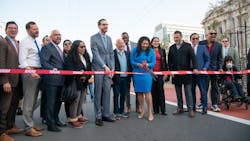Service begins on San Francisco’s Van Ness BRT corridor
State, city and transit officials gathered April 1 to celebrate the completion of the Van Ness Improvement Project and the start of bus rapid transit (BRT) on Van Ness Ave in the city of San Francisco.
The street serves as a regional connector between Marin, San Francisco and San Mateo Counites in the Bay Area. It is also one of the busiest north-south corridors in San Francisco with more than 16,000 daily customers on San Francisco Municipal Transportation Agency (SFMTA) and Golden Gate Transit routes.
SFMTA called the start of BRT service a “historic moment” as it is the first BRT corridor in the city and its arrival is expected to reduce transit times for SFMTA and Golden Gate Transit routes along the corridor by 32 percent.
“Today marks a significant step forward in our effort to transform transit safety and efficiency along one of San Francisco’s busiest corridors,” said San Francisco Mayor London Breed. “Not only does this project make Van Ness Avenue a more enjoyable place for residents and visitors to walk, bike and take public transit, it also helps get people out of their cars. In order to have a San Francisco that is livable and healthy for our residents, we must reduce emissions from transportation and make it easier for people to get around in more sustainable ways.”
Work to improve the corridor occurred at street level, as well as underground with the replacement of more than 22,000 feet of 19th century water mains, the construction of an earthquake-resistant sewer system and overhaul of the emergency firefighting water supply system.
The BRT corridor includes dedicated, separate transit-only lanes, which are also available to emergency vehicles; transit signal priority; nine fully furnished northbound and southbound boarding platforms; a repaired overhead catenary system that powers zero-emission buses; and low-floor vehicles and all-door boarding.
Pedestrian safety was also intentionally designed into the corridor with sidewalk extensions, median refuges, high visibility crosswalks and audible countdown signals; accessible pedestrian signals at crosswalks and boarding platform locations; and updated streetlights and sidewalk lighting.
“We have long awaited today’s momentous grand opening and can’t thank the city and the Van Ness corridor enough for their patience and cooperation,” said Jeff Tumlin, SFMTA director of transportation. “With a significant planned improvement in travel time for Muni and Golden Gate Transit, San Francisco’s first bus rapid transit system will serve our pedestrians, riders, motorists and wheel riders providing them with quick and safe transit, long lasting underground infrastructure and a beautified Van Ness Avenue.”
Construction on the estimated $346 million Van Ness Improvement Project began in March 2017, but the concept of rapid transit on Van Ness stretches back much farther. Voters approved a sales tax to plan rapid transit service on Van Ness in 2003 and 10 years later, the Van Ness BRT project was approved. The project was financed through a combination of federal grants and formula funds, as well as state and developer contributions.
About the Author

Mischa Wanek-Libman
Group Editorial Director
Mischa Wanek-Libman is director of communications with Transdev North America. She has more than 20 years of experience working in the transportation industry covering construction projects, engineering challenges, transit and rail operations and best practices.
Wanek-Libman has held top editorial positions at freight rail and public transportation business-to-business publications including as editor-in-chief and editorial director of Mass Transit from 2018-2024. She has been recognized for editorial excellence through her individual work, as well as for collaborative content.
She is an active member of the American Public Transportation Association's Marketing and Communications Committee and served 14 years as a Board Observer on the National Railroad Construction and Maintenance Association (NRC) Board of Directors.
She is a graduate of Drake University in Des Moines, Iowa, where she earned a Bachelor of Arts degree in Journalism and Mass Communication.
